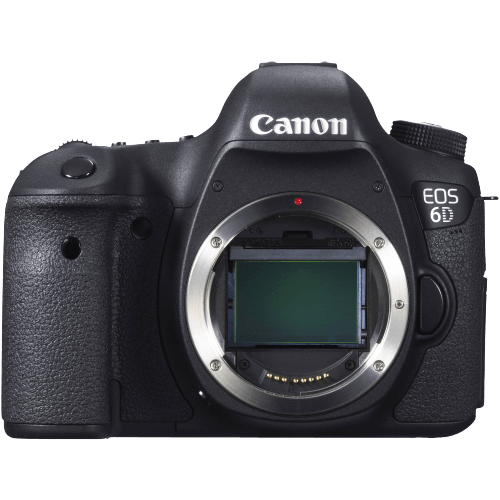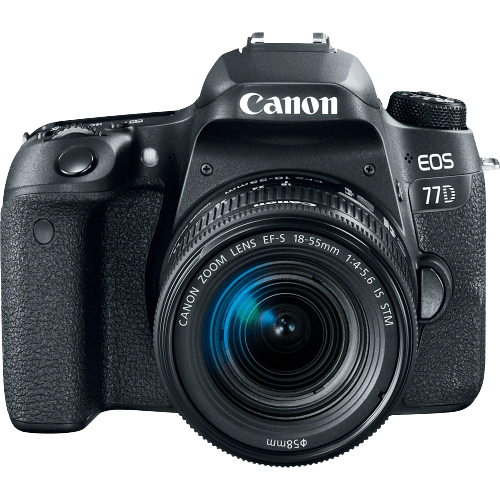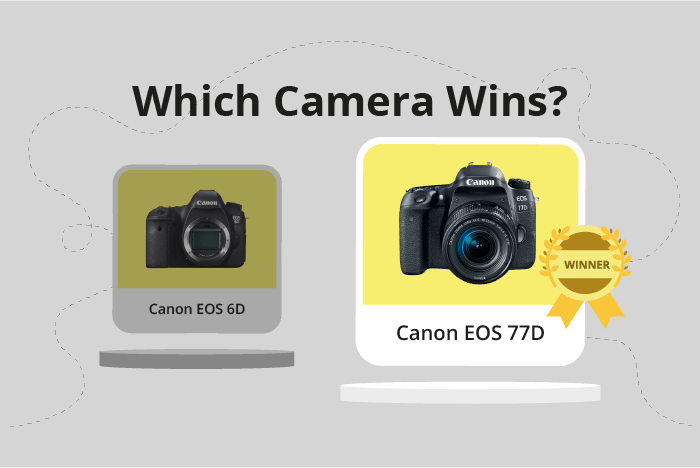Canon EOS 6D vs EOS 77D Comparison
Canon EOS 6D

Canon EOS 77D

The Canon EOS 77D outperforms the Canon EOS 6D with a score of 63/100 compared to 59/100. Both cameras are DSLRs, announced in 2017 and 2012 respectively. They share similar weights, with the 77D at 765g and the 6D at 770g. In terms of size, the 77D is slightly smaller at 131 x 100 x 76mm, while the 6D is 145 x 111 x 71mm.
The 77D’s higher score highlights its overall superiority. Its more recent release year and lower launch price of $900 make it a more attractive option than the 6D, which initially cost $2099. However, the 6D has its advantages, such as a larger size that might suit certain users better.
Considering these factors, the Canon EOS 77D is the better choice for most users due to its improved performance, lower price, and more compact design. The Canon EOS 6D, while still a solid camera, falls short in comparison.
Canon EOS 6D vs EOS 77D Overview and Optics
The Canon EOS 77D outperforms the Canon EOS 6D in optics, scoring 64/100 compared to the 6D’s 61/100. Both cameras share common specifications, including a CMOS sensor, no image stabilization, and compatibility with Canon’s EF lens mounts. However, the EOS 77D has a higher megapixel count, faster shooting speed, and a more advanced processor.
The EOS 77D’s 24.2 megapixels offer greater image resolution than the 6D’s 20.2 megapixels, resulting in sharper and more detailed photos. Additionally, the 77D’s shooting speed of 6 frames per second (fps) surpasses the 6D’s 4.5 fps, providing better performance when capturing fast-moving subjects. The EOS 77D also benefits from the powerful Digic 7 processor, which enhances image quality and processing speed.
On the other hand, the EOS 6D has a higher DXOMARK score for its sensor (82) compared to the 77D (78), indicating better overall image quality. The 6D also features a full-frame sensor, which is larger than the 77D’s APS-C sensor. Full-frame sensors generally produce better image quality, particularly in low light conditions. Consequently, the EOS 6D excels in low-light photography and offers a slight edge in overall image quality.
Despite the EOS 6D’s advantages in sensor quality and size, the EOS 77D’s higher score demonstrates its superiority in optics due to its higher megapixel count, faster shooting speed, and advanced processor. The 77D is the better choice for those who prioritize image resolution and capturing fast-moving subjects. However, the 6D remains a strong contender for photographers who require exceptional low-light performance and overall image quality.
Canon EOS 6D vs EOS 77D Video Performance
The Canon EOS 77D outperforms the Canon EOS 6D in video capabilities, scoring 70 out of 100 compared to the 6D’s score of 43. Both cameras share Full HD video resolution and maximum video dimensions of 1920 x 1080, but the similarities end there.
The EOS 77D surpasses the 6D with a maximum video frame rate of 60fps, double the 6D’s 30fps. This means the 77D captures smoother and more detailed footage, especially in fast-paced situations or when shooting slow-motion videos. Additionally, the 77D features built-in time-lapse functionality, enabling users to create stunning time-lapse videos without requiring external equipment or software. This added feature expands the creative possibilities for 77D users.
On the other hand, the EOS 6D does not offer any significant advantages in video capabilities over the 77D. Its lower frame rate and lack of built-in time-lapse functionality make it less versatile and less suited for capturing dynamic video content.
Considering each camera’s video capabilities, the EOS 77D emerges as the clear winner, offering smoother, higher frame rate video and built-in time-lapse functionality. The EOS 6D falls short in these aspects, making it less appealing for users seeking advanced video features. The higher score of the 77D reflects its superiority in video performance, and potential buyers should consider this factor when choosing between the two cameras.
Canon EOS 6D vs EOS 77D Features and Benefits
The Canon EOS 77D emerges as the winner in this comparison, scoring 70 out of 100 points in features, while the Canon EOS 6D scores 57 points. Both cameras share some common specifications, such as a 3-inch screen size and a screen resolution of 1,040,000 dots. Additionally, both cameras have WiFi capabilities.
The EOS 77D has several advantages over the 6D. For instance, it features a touchscreen, making it easier for users to navigate menus and adjust settings. Moreover, the 77D has a flip screen, which is useful for capturing images and videos from different angles. The inclusion of Bluetooth connectivity also provides additional convenience for transferring files and remote control.
On the other hand, the EOS 6D has one significant advantage over the 77D: GPS functionality. This feature allows photographers to geotag their images, making it easier to locate and organize photos based on location.
In terms of features, the Canon EOS 77D offers more versatility and convenience due to its touchscreen, flip screen, and Bluetooth connectivity. These attributes make it a better choice for those who value ease of use and flexibility. However, the Canon EOS 6D’s GPS functionality might be more appealing to photographers who prioritize geotagging capabilities for organizing and cataloging their work. While both cameras have their strengths, the EOS 77D’s higher feature score reflects its overall superiority in terms of user-friendly and versatile features.
Canon EOS 6D vs EOS 77D Storage and Battery
The Canon EOS 6D outperforms the Canon EOS 77D in storage and battery, scoring 45 out of 100 compared to the 77D’s 29. Both cameras have one memory card slot and accept SD, SDHC, and SDXC cards. However, the 77D is compatible with UHS-I cards, offering faster transfer speeds.
The 6D has a longer battery life, providing 1090 shots per charge with its LP-E6 battery, whereas the 77D delivers 600 shots using its LP-E17 battery. Neither camera supports USB charging. The 6D’s superior battery life makes it a more reliable option for extended shooting sessions.
While the 77D has the advantage of UHS-I compatibility, its shorter battery life limits its overall performance in storage and battery. The Canon EOS 6D emerges as the better choice in this category due to its longer battery life, ensuring photographers can capture more moments without interruption.
Canon EOS 6D vs EOS 77D – Our Verdict
Are you still undecided about which camera is right for you? Have a look at these popular comparisons that feature the Canon EOS 6D or the Canon EOS 77D:

